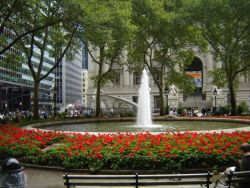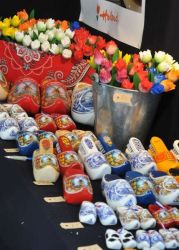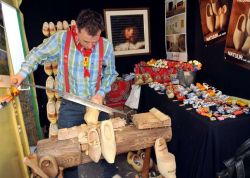Bowling Green
The Daily Plant : Monday, August 26, 2002
I LOVE (TO LEARN ABOUT) NY
Judging from rent prices—and the traffic—New York City continues to be one of the most desirable destinations in the world. I already knew this, you say. Well, "smarty pants," the Daily Plant would like to teach you a few things you might not know about this great city. Here are a few more reasons why New York is great…
What’s in a Nickname? (or, How New York City Became "Gotham")
Washington Irving used this Anglo-Saxon word meaning "goat town" satirically in his 1807 series "Salmagundi: or, the Whim-whams and Opinions of Launcelot Langstaff and Others." He was satirizing the habits of New Yorkers by comparing them to the residents of Gotham, a village in Nottinghamshire, England. According to an old English folk tale published in the 16th century, the people of the town wanted to discourage King John and his entourage from taking up residence in the town. They did this by feigning madness, engaging in crazy tasks like drowning eels and building fences around bushes to trap birds. Their plan worked, and the town was spared the expense of a royal visit. When he named New York "Gotham," Irving likening the eccentricities of the city’s residents to an organized strategy to have outsiders leave them alone.
Reaching New Heights at Fresh Kills Landfill in Staten Island
Stretching along a waterway called the Arthur Kill, Fresh Kills encompasses more than 2000 acres, over two and one half times the size of Central Park, it has four garbage mounds that reach from 90 to 225 feet above sea level. The landfill contains diverse terrain, habitats and vegetation; roughly half of the site has never been filled with garbage or was filled more than twenty years ago. The City’s Department of Sanitation is working with the State to ensure environmentally sound closure of the landfill sections and to prepare long-term environmental monitoring and control systems.
No, You Don’t Need Special Shoes To Enter Bowling Green…
According to tradition, Bowling Green was the site of the legendary sale of Manhattan to Peter Minuit in 1626. The Dutch colonists called the area "the Plain" and used it for several purposes. It was the beginning of Heere Straat (High Street, now Broadway)—a trade route which extended north through Manhattan and the Bronx. It was also a parade ground, meeting place, and cattle market. In 1686, the site became public property, when the City Charter put all "waste, vacant, unpatented and unappropriated lands" under municipal domain. Bowling Green was first designated as a park in 1733.
We’re Going Around In Circles Here
In 1970, the first New York City Marathon was held and consisted of four-plus laps around Central Park. The race had 55 finishers and a total budget of $1,000. In 1976, to celebrate the U.S. bicentennial, the marathon moved from Central Park to the streets of New York City’s five boroughs.
One Out Of Three Species Birds Recommends Central Park…
Of the 800 species of birds found in North America, you can find 275 of them in Central Park. Species include Red Tailed Hawks, Long Eared & Screech Owls, Peregrine Falcons, Cerulean, a variety of Warblers (including golden, orange-crowned, blue winged, and yellow throated), Black-crowned Night Herons, Rusty Blackbirds, Scarlet Tanagers, Yellow-breasted Chats, Ruddy Ducks, Horned Grebes, Common Loons, as well as an amalgamation of Sparrows, Finches, and Pigeons.
GOOD LUCK, NADINE LEHRER
WEP workers and staff bid farewell to Nadine Lehrer as she leaves for Peru under the internationally-acclaimed Fulbright Program.
Nadine Lehrer has worked for Parks for the last three years. She began as the assistant director of WEP in 1998 and has been climbing her way through Parks, leaving her mark on every branch. As the assistant director of WEP, Nadine conducted field inspections of WEP crews and crew chiefs, and created and implemented the 1999 Crew Chief training classes, which helped participants gain full time employment.
Nadine’s caring and positive attitude spreads beyond her colleagues and Parks to the environment. In 2000, Nadine became an Arborist Apprentice in the Forestry Division of Parks, maintaining and attending to street and park trees. In 2002, our world class scholar was also a world class traveler, going to exotic places to increase her expertise. She has worked in Panama, studying damsel flies and on a sheep farm in Maine, studying rare-breed animals. May 2002 proved to be a redwood-measured accomplishment, as Nadine was the first woman hired in 15 years for the much advocated and highly competitive Tree Maintenance program in NYC.
In Peru, Nadine will be studying Agro-Forestry practices with the Universidad Nacional Agraria La Molina and farmers from rural areas. She will be missed by everyone at Parks as she plants the seeds for a better environment for all. Best of Luck, Nadine!
Written by Janelle Lewis
THIRTEEN YEARS AGO IN THE PLANT
(Monday, September 4, 1989)
MAYOR KOCH BREAKS GROUND FOR NEW PROSPECT PARK ZOO
Kids and animals make a natural pair. And in Brooklyn, the City is creating a special place to bring children together and a variety of creatures from around the world at the soon-to-be restored Prospect Park Zoo.
On Tuesday, nearly 100 New Yorkers helped break ground for the $36 million capital restoration of the landmarked zoo, including Mayor Koch, Brooklyn Borough President Howard Golden, City Council Member Steve DiBrienza, New York Zoological Society General Director Dr. William Conway, and Commissioner Stern.
QUOTATION FOR THE DAY
"Just the facts, Mam"
Jack Webb as Detective Joe Friday on Dragnet











